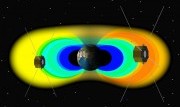Both RBSP-A and -B are now turned off.
RBSP-A thrusters ran out of propellant on August 29, 2019. The instruments were
turned off October 14, 2019.
RBSP-B ended life on July 16, 2019 due to earlier loss of propellant resulting in
loss of attitude control.
The complete EMFISIS/MAG data set has been processed once in what is called
"version 3". Version 3 data was produced as the data was recorded and made
available by the mission.
The data is a challenge to calibrate and process. Fluctuation levels are low
while the mean field strength changes rapidly. Traditional calibration methods
do not work. After lengthy study, we have developed new calibration codes for
this mission and are now reprocessing the entirety of the EMFISIS/MAG catalog.
Wherever possible, "version 4" data should be used. When unavailable, version 3
data is available, but should be assumed to be less accurate. Quick-Look data
should no longer be used for this mission as supperior data is always available.
Current best data are:
Version 4 data is available for RBSP-A from launch through 2019-10-14.
Version 4 data is available for RBSP-B from launch through 2019-07-16.
Version 3 data is available for RBSP-A from 2012-08-31 through 2019-10-14.
Version 3 data is available for RBSP-B from 2012-08-31 through 2019-07-16.
Note to data users:
RBSP-A end of life came October 14, 2019.
RBSP-B end of life came July 16, 2019.
Day July 12, 2019 for RBSP-A is significantly incomplete.
Days July 13-19, 2019 for RBSP-A has several minutes to several hours of incomplete
data.
Days December 27, 2018 and December 29, 20188 for RBSP-B are slightly incomplete.
Day June 22, 2018 for RBSP-B is significantly incomplete due to downlink issues.
Days April 29-30, 2017 for RBSP-A are significantly incomplete.
Day April 22, 2017 for RBSP-B is significantly incomplete due to downlink issues.
There is an unrecoverable gap for RBSP-A from July 29, 2016 at 23:14:56 UT to
July 30, 2016 at 00:45:40 UT.
There is an unrecoverable gap for RBSP-A on July 17, 2016 from 15:48:18 to 17:21:36 UT.
There is an unrecoverable gap for RBSP-A spanning June 22 & 23, 2016.
There is an unrecoverable gap for RBSP-A on June 17, 2016 from 01:48:55 to 03:20:19 UT.
Large data gap for RBSP-A on May 11, 2016.
Large data gap for RBSP-B on May 7, 2016. Awaiting more data.
Large data gaps for RBSP-A on April 9 and 11, 2016.
There is a 10% data gap for RBSP-A on February 14, 2016.
There is a significant data gap for RBSP-A on January 11-12, 2016 with lost and
unrecoverable data.
There is a significant data gap for RBSP-A on November 20, 2015 with lost and
unrecoverable data.
There is a significant data gap for RBSP-A on November 7, 2015 with lost and
unrecoverable data.
A single even upset at approximately 19:45 UT on October 9, 2015 triggered a
contingency mode which required a processor reset at 20:41 UT on October 13 to
return to normal operations. During this time the MAG instrument was forced into
Range-3. The resolution of the data was degraded while in Range-3 and cannot be
corrected.
There is a significant data gap on September 15-16, 2015 due to lost and
unrecoverable data.
The processing code failed to address the June 30, 2015 leap second. There also
appears to have been an less-than-correct ephemeris file used at this time. Data
from June 30 to July 21, 2015 contained discontinuities and have been corrected
with version 3.4 of the data.
Due to storm activity and perhaps other reasons we do not yet fully understand,
calibrations are still rough from March 2015 onward and will be improved.
Production continues for intervals after the above as data becomes available.
A reprocessing of all L1, L2 and L3 data is planned for the near future.
We are working to bring into production new calibration codes that will reduce
the spin tone below current levels. We remind the user that we are already
delivering data at superior accuracy than originally promised and hope that the
new codes will improve our performance.
QL-uvw is processed routinely to keep within a few days of measurement.
Current production codes and kernels include a 1.5 Hz signal that is Spice related
and largely removed at this time, an 11-sec signal that is the spin tone due to less
than ideal calibration that we hope will be removed very soon, and a 5-min nutation
signal that is largely the result of removing the star tracker from the spacecraft.
There is a 14.5 Hz signal on spacecraft A that arises from an aliased heater line.
We now believe that inertial frame data contains significant errors during times of
eclipse from 03/04/2013 through 04/07/2013. Data at these times are suspect with
up to 30 nT errors near apogee and the problem is most evident near the boundaries
of the eclipse. Errors are greatest during times of longest eclipse.
Both QL, L2 and L3 data sets are within the promised accuracy. Examination of the
data has taught us that to obtain good and usable spectra we must exceed the promised
instrument calibration and processing goals. We are working on that now.
New Spice-handling codes have been written and are now being tests with new Spice
production codes by APL. MAG instrument calibration continues and is not yet final.
The above L2 and L3 data will be reprocessed when both Spice processing and cals are
finalized.
For questions regarding data quality and availability please contact:
Dr. Scott R. Bounds, EMFISIS Project Manager,
Physics Department, University of Iowa, Scott-Bounds@uiowa.edu
Copies of questions can be sent to:
Prof. Craig Kletzing, EMFISIS Principal Investigator,
Physics Department, University of Iowa, Craig-Kletzing@uiowa.edu
Mr. Daniel Crawford, EMFISIS SOC Manager,
Physics Department, University of Iowa, Daniel-Crawford@uiowa.edu
Prof. Charles W. Smith, MAG Data Manager,
Space Science Center, University of New Hampshire, Charles. Smith@unh.edu
